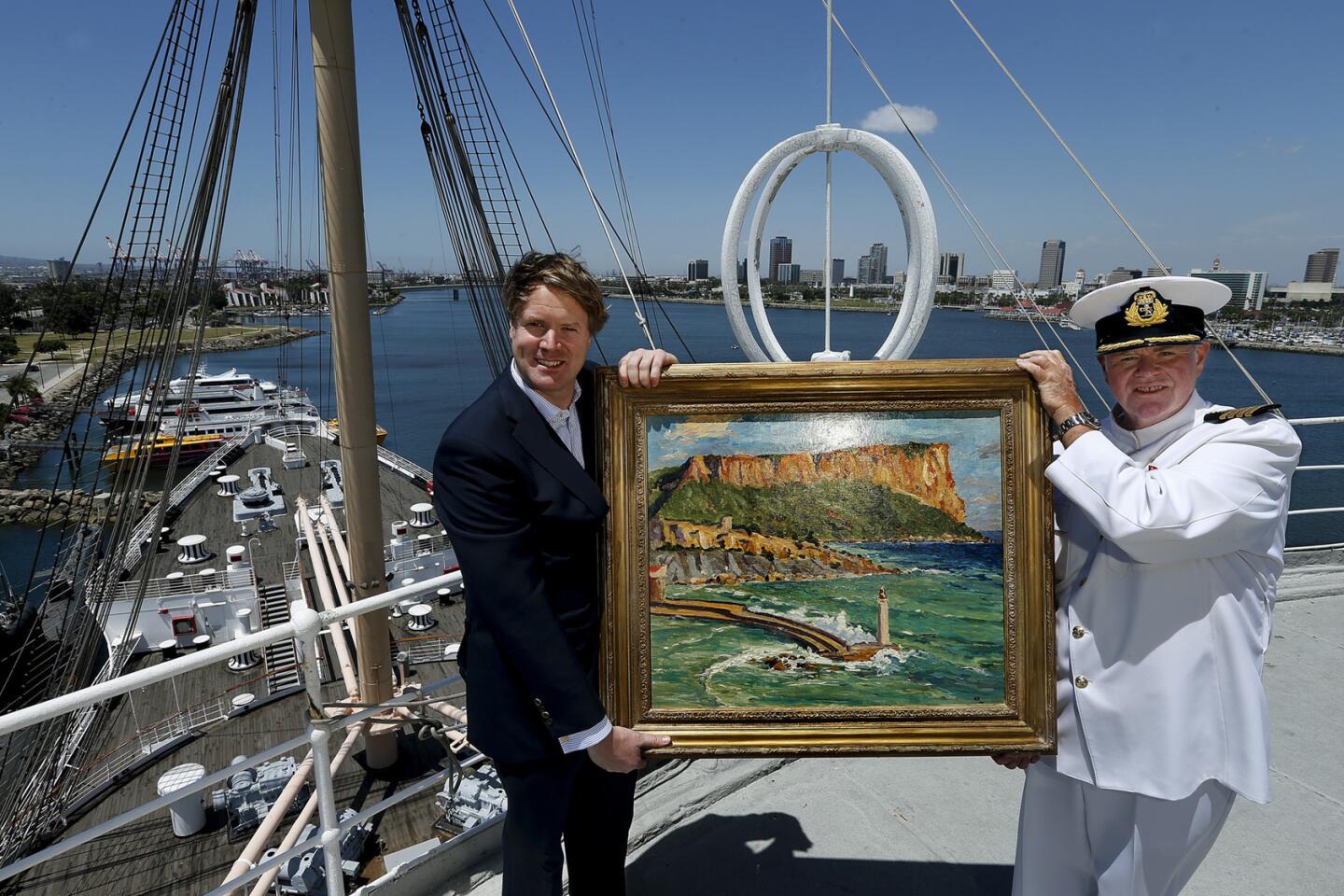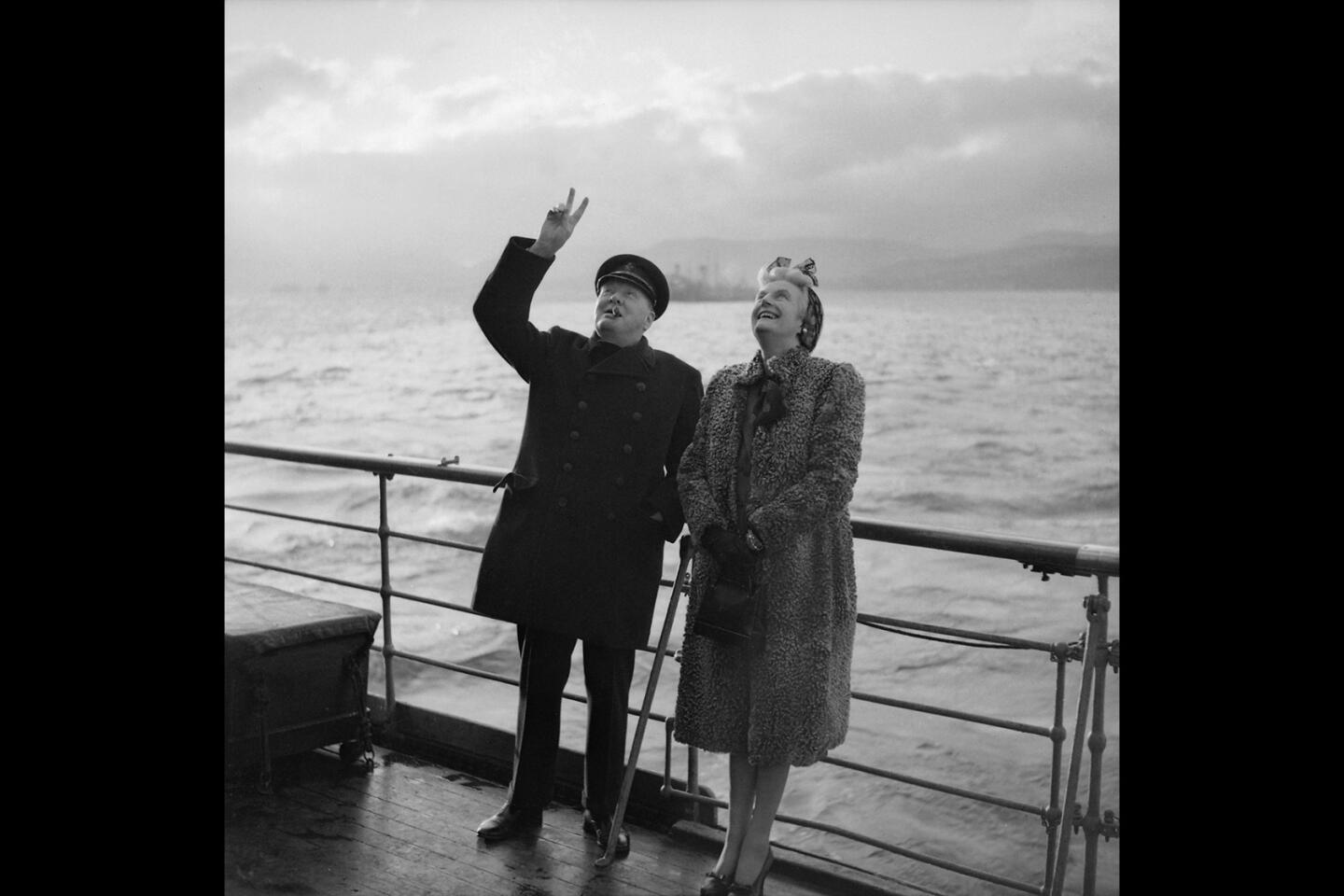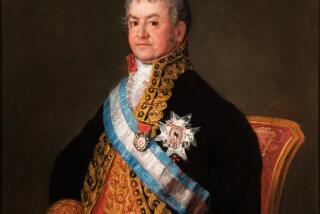Winston Churchill’s paintings star in an exhibit on the Queen Mary

- Share via
It was late summer 1939. Winston Churchill, then a member of the British Parliament, and artist Paul Maze were leisurely painting at their easels by a babbling brook in the French countryside. Suddenly, a young messenger boy came running across the field, clutching a telegram. “Situation worsening,” it read. “Advice: Come home. You might have a job,” Maze would later recall in a documentary.
Maze began packing up his belongings. Churchill, paintbrush in hand and cigar wedged in his mouth, did not turn from his canvas. “You’ll finish that painting,” he scolded. “You won’t do another one for another four years.”
Days later, the Second World War broke out. Restored by the relief that painting provided him, Churchill soon took leadership of the British navy and rode the Queen Mary into the Atlantic. He would become British prime minister the following year.
Churchill was known for his prolific writings, eloquent speeches and political leadership. Lesser known was his love affair with painting, his refuge from the stresses of politics and journalism. During especially trying times, political and personal, painting was how Churchill staved off what he called “the black dog” of depression.
Ten of Churchill’s landscapes and seascapes will be on view in “Passion for Painting: The Art of Winston Churchill Exhibit Aboard the Queen Mary,” opening May 27. The storied ship — prized as a feat of engineering and luxury in its time and Churchill’s floating battle headquarters during World War II — celebrates the 80th anniversary of its maiden voyage this month. To mark the occasion, the ship will open an art gallery with Churchill’s works, which will hang for at least six months. Maze’s portrait of Churchill at his easel, painted that day the telegram arrived in France, also will be on view.
The exhibit is a collaboration between the Queen Mary and the National Churchill Museum at Westminster College in Fulton, Mo. Eight of the paintings come from the private collection of the family of Churchill’s grandson, the late Julian Sandys; they’re normally on the walls of family members’ homes in London. The others are from the Churchill museum.
Churchill’s art work went on tour to the U.S., Canada, Australia, New Zealand and the Royal Academy of Arts in London in 1958 and ’59. Exhibits commemorating the 50th anniversary of the statesman’s death in 1965 were on display at the Millennium Gate Museum in Atlanta in 2014 and last year at the Mildred Lane Kemper Art Museum at Washington University in St. Louis, in conjunction with the National Churchill Museum. But this will be the first time so many of the paintings will be shown on the West Coast.
“Painting was essential to Churchill. It’s where he went to restore himself,” Churchill great-grandson Duncan Sandys says aboard the Queen Mary. “He’d be consumed by painting. It would refresh his mind. It gave him the ability to step back from any situation, have a change of scenery, then go back and look at the problem from a different perspective.”
In his lifetime, Churchill wrote more than 5,000 speeches and 43 book-length works, not to mention steered a political career and a family. Painting was not only part of this “prodigious output,” Sandys says, but “it’s also what enabled everything else.”
Churchill didn’t begin painting until after he was 40. The hobby grew out of desperation. In 1915, after the ill-fated Battle of Gallipoli during World War I, he was forced to resign as first lord of the Admiralty and fell into a depression. While he was vacationing in the English countryside, his sister-in-law, Gwendoline “Goonie” Churchill, a watercolorist, offered him her paintbrush. He took to it immediately and began experimenting with his nephew’s paints soon after. Churchill went on to study oil painting with his neighbor friends in London, Irish painter John Lavery and his wife, Hazel, as well as with other artist friends such as Maze, but he wasn’t professionally trained. Instead, he spent hours wandering art museums studying the treasures they housed.
Over his lifetime, Churchill painted more than 500 works, mostly while on holiday or at home in London or in the countryside. He carted his paintbrush and enormous easel when traveling, even for work. He was inspired by the French Impressionists and Post-Impressionists and painted a large portion of his canvases in the South of France. He was taken by the light and colors there, particularly the reflections of light on water. He modeled his work after painters such as John Singer Sargent and especially Paul Cézanne. In 1948, the Royal Academy of Arts named Churchill an honorary academician extraordinary.
But he didn’t create to exhibit or sell. He considered himself a hobbyist and painted only for pleasure, storing most of his finished paintings in his Chartwell studio or on the walls of his homes.
Churchill’s painting style matured over the years, and his brushwork became more refined, exhibit curator Tim Riley says. But what stands out are the similarities in the works: bold colors, swift brush strokes and “that contrast of light and color that fascinated him throughout his career,” Riley adds.
Like all of us, Riley says, Churchill had good days and bad days, “but some of his best paintings could hang in a gallery beside Impressionists and Post-Impressionists without trouble.”
Painting changed the politician’s writing style, Sandys says. In his pre-1915 speeches, his great-grandson notes, Churchill’s writing was fairly technical. After he took up painting, his speeches were peppered with visual references to light and color, his imagery more vivid.
“This was radio, there were no visuals,” Sandys says of the era. “Yet he was able to create this wonderful sort of vision, this painting, that people could see and understand. It’s what so inspired them and enabled him to rally people across the world.”
The earliest painting in the exhibit, from 1922, depicts Churchill’s eldest child, the then-13-year-old Diana, pensively wandering along a light-dappled, grassy path beneath a canopy of trees. This was a difficult time in Churchill’s life; the year before, his daughter Marigold had died. The image of a young girl emerging from what looks like a tunnel of light has an almost restorative quality.
The latest work in the show is from 1951, a scene from the Palazzo Vecchio in Florence, Italy. Dark shadows across cool stone columns stand in stark contrast to the sun-lit water trickling off a courtyard fountain.
Churchill’s paintings from the South of France, such as one from along the Var River, where Cézanne also painted, depict peachy dirt paths, patches of green grass and the purple-hued French Alps — a palette reminiscent of the Impressionist painters he so loved.
“He famously wrote that he loved bright colors and felt sorry for the greens and the browns,” Sandys says.
The Queen Mary exhibit also includes artifacts from the National Churchill Museum, such as Churchill’s leather travel clock, which he used on the ship; the British flag Churchill stood in front of when delivering his “Iron Curtain” speech at Westminster College in March 1946; as well as a never-before-exhibited letter, handwritten aboard the ocean liner, from Churchill to his eldest grandson, Julian Sandys. Churchill’s beloved travel easel will also be on display, along with a 13-minute film about his relationship with the Queen Mary, produced by the ship.
The new art gallery was built in the ship’s former third-class smoking room, a lounge once used for drinks, conversation and card games. During the renovation, original Art Deco elements were uncovered beneath layers of drywall. After the Churchill show, the space will be used for historical exhibits.
Two days of anniversary events are planned. A gala dinner, open to the public, will be held May 26 in the Queen’s Salon. Randolph Churchill, another of Winston’s great-grandsons, will address guests, as will Alan Watson, a member of Parliament and a Churchill scholar. The new art gallery will be dedicated May 27 — the official anniversary — during which admission to the Queen Mary will be free.
An hour-long documentary, “Queen Mary: Greatest Ocean Liner,” a co-production of the BBC, BBC Four, the Smithsonian Channel and Scottish Television Productions, will premiere May 24 in Britain and will air in the U.S. this summer. The film will be screened in the Queen Mary’s theater during the anniversary weekend. It includes interviews with former passengers, crew members and entertainers such as Johnny Mathis who all talk of life-changing experiences while traveling on the ship.
Anchoring the celebrations will be the Churchill paintings.
“Happy are the painters, for they shall not be lonely,” Churchill wrote in his essay “Painting as a Pastime,” published in the Strand Magazine in the early 1920s. “Light and colour, peace and hope, will keep them company to the end, or almost the end of the day.”
More to Read
The biggest entertainment stories
Get our big stories about Hollywood, film, television, music, arts, culture and more right in your inbox as soon as they publish.
You may occasionally receive promotional content from the Los Angeles Times.













